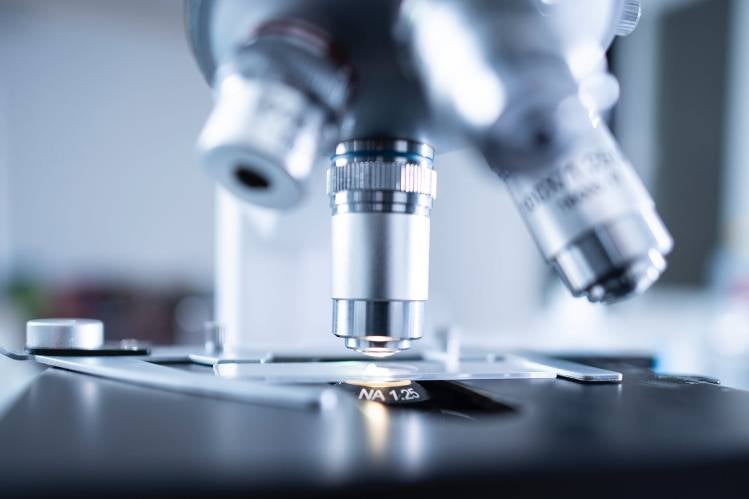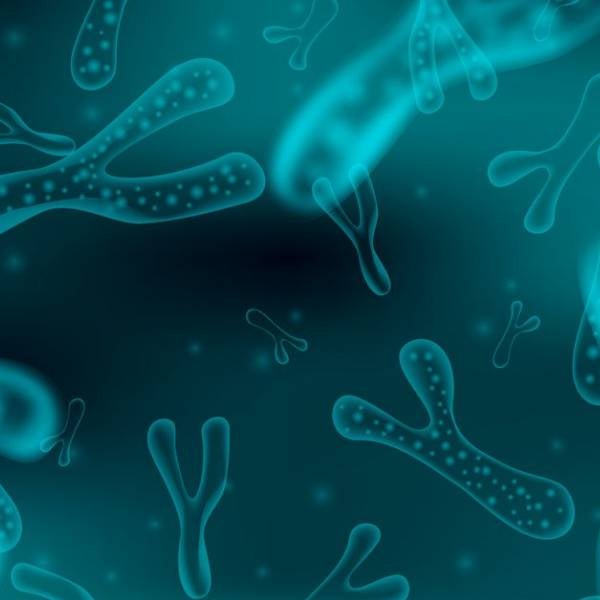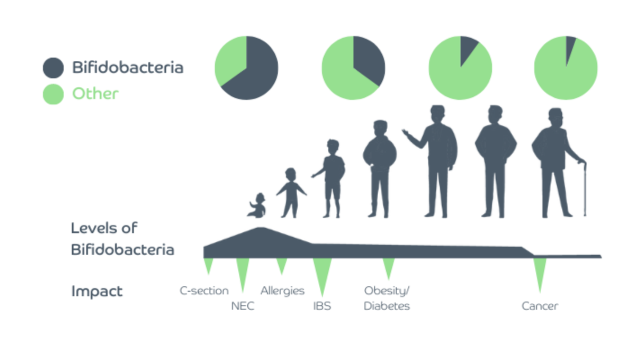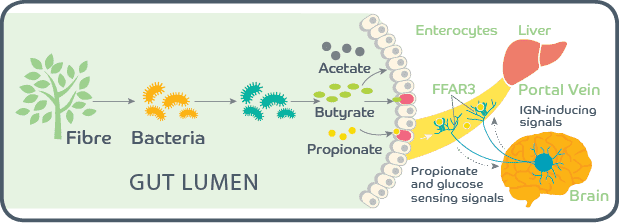All being well, we start our lives with a healthy gut microbiome as the ‘good’ bacteria bifidobacteria naturally colonises our gut microbiome in infancy. For years, research has demonstrated an association between bifidobacteria with health-promoting effects. Many bifidobacteria species are now often isolated as an ingredient for functional foods and supplements.
Bifidobacteria is thought to be beneficial to health through several mechanisms including:
- protecting the host against pathogens by competitive exclusion
- playing a role in development and modulation of the immune system
- providing nutrients and metabolites (such as vitamins, short-chain fatty acids (SCFAs) by breaking down non-digestible dietary carbohydrates
- cross-feeding other health-promoting bacteria and decreasing the gut pH, making it more difficult for pathogenic bacteria to grow in the GI tract
- involvement in production of neurotransmitters important for brain function
- protection and maintenance of the gut barrier.

The genus bifidobacteria are Gram-positive, non-motile, non-spore forming, anaerobic bacteria from the phylum Actinobacteria. They inhabit many parts of our body including the digestive system. They were first discovered in 1899 when they were isolated in breast-fed infants. Bifidobacteria utilise a unique carbohydrate metabolism pathway called phosphoketolase pathway or bifid shunt, which does not involve producing any gas during fermentation. This distinguishes bifidobacteria from other gut bacteria.
Which health effects are bifidobacteria linked to?
As with all bacteria, the functionality of each varies at a species level[1].
There are over 50 identified species and the ones most studied in relation to human health include Bifidobacterium bifidum, Bifidobacterium infantis, Bifidobacterium adolescentis and Bifidobacterium longum[2].
In the gut they break down non-digestible carbohydrates to produce short-chain fatty acids (SCFAs), can improve GI symptoms, protect and/or maintain the gut barrier, influence the immune system, and inhibit inflammatory responses[3].
The prebiotic fibre
supplement Bimuno® feeds good gut bacteria and has a higher selectivity towards
bifidobacteria[4].
How much bifidobacteria do we naturally have?
Several factors, starting from the mode of delivery, to breastfeeding, gender, age, geographic location, disease, medication use and long-term dietary intake, influence the activity and composition of the community of the trillions of microorganisms inhabiting the gastrointestinal tract, including bifidobacteria. Bifidobacteria represent the majority of the bacteria in gut microbiome of breast-fed babies.
Infants fed human breast milk have higher numbers of bifidobacteria than formula-fed babies. This is due to the presence of the prebiotic oligosaccharides in human breast milk, which are preferentially selected by, and increase the numbers of bifidobacteria. As an infant develops, a more varied diet is introduced, which includes fats and protein which are not substrates for bifidobacteria. This contributes the age-related decline of bifidobacteria as their food source is reduced. Other environmental factors, such as medication including antibiotics, contribute to the drop in bifidobacteria. During adulthood, bifidobacteria levels decrease considerably but remain relatively stable, decreasing again in old age.
How can levels of bifidobacteria increase in the gut microbiome?
One way to increase levels of good gut bacteria, including bifidobacteria, is to optimise dietary intake, which will naturally include prebiotics. Prebiotics are non-digestible food compounds that beneficially affect the host by selectively stimulating the growth and/or activity of one or a limited number of bacteria in the colon and improving host health.
The prebiotic fibre supplement Bimuno® feeds good gut bacteria and has a higher selectivity towards bifidobacteria[4] compared with other commercially available prebiotic supplements. Bimuno® may be particularly useful if an individual is unable to tolerate foods which contain prebiotics such as onions, Jerusalem artichokes and leeks, and/or if they are following a low-FODMAP diet.
Bifidobacteria are also available as live strains (probiotics).
How do bifidobacteria in the gut exert an effect?
- Colonic Fermentation: Bifidobacteria produce lactic acid and SCFAs (end‐products of bacterial fermentative reactions in the colon; mainly acetate, propionate and butyrate), which can have direct signalling functions in the host and also cross feeds other beneficial bacteria to create more or other SCFAs. One of SCFAs’ major properties is their protective effect on the gut epithelium. Moreover, butyrate, is an important energy source for the colonic epithelium and regulates cell growth and differentiation.
- Vitamin synthesis: Gut bacteria, including bifidobacteria can synthesize vitamins, especially several B vitamins and vitamin K.
- Gut barrier effects: Bifidobacteria has been shown to enhance and maintain gut barrier effects by normalising tight-junction proteins and inhibiting inflammatory responses and inflammation-induced gut leakiness.
- Effects of colonic immune system: Bifidobacteria are known to modulate the physiology of the Gut-Associated Lymphoid Tissue (GALT) and therefore play an important role in the regulation of immune responses.
References


